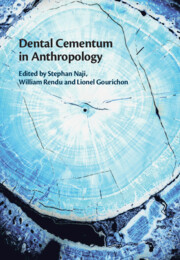Book contents
- Dental Cementum in Anthropology
- Dental Cementum in Anthropology
- Copyright page
- Dedication
- Contents
- Contributors
- Foreword
- Introduction: Cementochronology in Chronobiology
- Part I The Biology of Cementum
- Part II Protocols
- Part III Applications
- 17 Using Cementochronology to Discuss the Organization of Past Neanderthal Societies
- 18 Investigating Seasonal Competition between Hominins and Cave Hyaenas in the Belgian Ardennes during the Late Pleistocene: Insights from Cementum Analyses
- 19 Cementochronology to the Rescue: Osteobiography of a Middle Woodland Woman with a Combined Skeletal Dysplasia
- 20 Estimating a Mortality Profile of Fisher-Gatherers in Brazil Using Cementochronology
- 21 Cementochronology: A Solution to Reconstructing Past Populations’ Mortality Profiles Using Individual Age-at-Death Estimates
- 22 Assessing Age-Related Mortality at Petra, Jordan, Using Cementochronology and Hazard Modeling
- 23 Shaping Age-at-Death Distributions by Applying Tooth Cementum Analysis to the Early Medieval Graveyard of Lauchheim (Germany)
- 24 Back to the Root: The Coming of Age of Cementochronology
- Index
- Plate Section (PDF Only)
- References
19 - Cementochronology to the Rescue: Osteobiography of a Middle Woodland Woman with a Combined Skeletal Dysplasia
from Part III - Applications
Published online by Cambridge University Press: 20 January 2022
- Dental Cementum in Anthropology
- Dental Cementum in Anthropology
- Copyright page
- Dedication
- Contents
- Contributors
- Foreword
- Introduction: Cementochronology in Chronobiology
- Part I The Biology of Cementum
- Part II Protocols
- Part III Applications
- 17 Using Cementochronology to Discuss the Organization of Past Neanderthal Societies
- 18 Investigating Seasonal Competition between Hominins and Cave Hyaenas in the Belgian Ardennes during the Late Pleistocene: Insights from Cementum Analyses
- 19 Cementochronology to the Rescue: Osteobiography of a Middle Woodland Woman with a Combined Skeletal Dysplasia
- 20 Estimating a Mortality Profile of Fisher-Gatherers in Brazil Using Cementochronology
- 21 Cementochronology: A Solution to Reconstructing Past Populations’ Mortality Profiles Using Individual Age-at-Death Estimates
- 22 Assessing Age-Related Mortality at Petra, Jordan, Using Cementochronology and Hazard Modeling
- 23 Shaping Age-at-Death Distributions by Applying Tooth Cementum Analysis to the Early Medieval Graveyard of Lauchheim (Germany)
- 24 Back to the Root: The Coming of Age of Cementochronology
- Index
- Plate Section (PDF Only)
- References
Summary
Accurate age-at-death estimates are essential for inferring health, identity, diversity, and demography within archaeological skeletal samples. Unfortunately, the macroscopic skeletal structures may be compromised by dysplastic, endocrine, and circulatory disorders. Cementochronology provides a reliable alternative approach for evaluating acellular cementum banding. Using cementochronology, we present an age-at-death estimate for a pre-Columbian, adult female with a combined skeletal dysplasia, achondroplasia and Leri-Weill dyschondrosteosis. Cementochronology has re-defined the age-at-death estimate between 30 to 34 years. These results not only assist in developing a more accurate age-at-death estimation and biological profile, but they also facilitate creating nuanced interpretations for a physically challenged, pregnant female in her Middle Woodland social context. Further, this analysis emphasizes the utility of cementochronology in estimating age-at-death of skeletal individuals with pathological conditions that compromise commonly used macroscopic methods and encourages researchers to consider this technique in paleodemography, paleoepidemiology, and forensic anthropology.
Keywords
- Type
- Chapter
- Information
- Dental Cementum in Anthropology , pp. 306 - 321Publisher: Cambridge University PressPrint publication year: 2022



